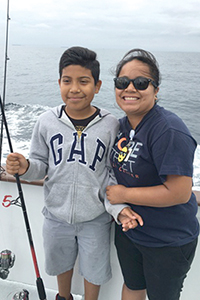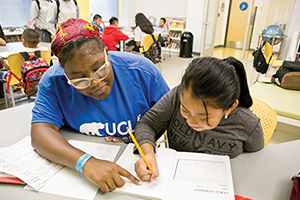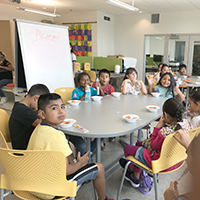By ELIZABETH GARONE
Marilyn Ginez spent her early childhood traveling back and forth from her home in Mexico to Los Angeles where her parents had relatives and had lived before she was born. When she was in first grade, her parents decided to move back to the United States and they moved the family into a studio apartment in downtown Los Angeles. When they first arrived, her parents sold fruit on street corners to make ends meet.

As a child, Marilyn Ginez found support and friendship at the Hope Street Margolis Family Center in Los Angeles; now she works there. She is shown here with David Bautista, one of the students on the organization's annual fishing trip for children. The outing is hosted by the Los Angeles Rod and Reel Club.
"Coming to a new place not knowing any English was tough. My oldest sister was in second grade, and we both were struggling to learn the new language," remembers Ginez, now 25.
But luckily for Ginez and her sister, her family found what she describes as "a second home" at the Hope Street Margolis Family Center, a community resource of Dignity Health's California Hospital Medical Center.
Both girls enrolled in after-school programs there and almost immediately started to feel a part of the community. Their English skills improved.
At Hope Street "I found people who have guided me through and helped me become the person I am today," says Ginez.
One of those people was Gina Avila, the organization's education coordinator, who became so much a part of Ginez's life that Avila attended both her middle-school and high-school graduations. "She has been a role model for me," says Ginez. "I saw how much love and dedication she gave to me and my peers while growing up being part of the program that I told myself that I one day want to be like her."
Early head start
Services offered at Hope Street include home visits for new parents, support for families where there has been child abuse or neglect, parenting classes, English as a second language classes for parents, a children's mental health clinic, and preschool and after-school recreation and education programs.
Hope Street opened in 1992 with only three employees. Today, the organization has a staff of 140 and three locations, and serves 5,000 low-income children and families each year. Most clients are Latina and Latino with many coming from Guatemala, El Salvador, Nicaragua and southern Mexico. There is no charge to clients. The requirement for receiving services is income at or below the poverty line.
Hope Street's work is closely tied to California Hospital Medical Center's busy labor and delivery department. From 4,000 to 5,000 babies are delivered there each year, according to Hope Street Margolis Family Center's Director Vickie Kropenske. She's been with Hope Street since it opened its doors more than a quarter of a century ago. The hospital is half a mile from Hope Street's main location. Kropenske is the one person at Hope Street employed by the University of California, Los Angeles; everyone else works for Dignity Health.

Princess Amugo, a UCLA BruinCorps tutor, works with Gladys Velasquez at Dignity Health's Hope Street Margolis Family Center in Los Angeles. The BruinCorps tutors are UCLA undergraduates who teach literacy, language arts and math skills to students from kindergarten through ninth grade.
"Our work is to continue the support for these young families and to make sure that the babies that are born here have the support and their parents have the support to ensure strong early developments in health," she says.
Clients find out about Hope Street from other clients; they can self-refer or get referrals from legal and housing agencies, churches and other faith-based organizations, the Department of Children and Family Services, and other organizations and individuals. Some people find out about Hope Street's programs simply by walking in and inquiring — most clients live in the surrounding neighborhood.
Full circle
Kropenske says as Hope Street provides important services to the community, it works to "develop capacity within the community and for the families and the children that we serve to help develop a sense of service and an interest in giving back to their community."
Ginez is a prime example of this ethos. As soon as she graduated from high school, she started volunteering at Hope Street "every little chance" she got and eventually landed a position as a team leader for 25 second, third and fourth graders. She makes sure her students are engaged in the day's activities and that they act respectfully to staff and each other. She talks to parents when there is a concern with their child's behavior. During the summer program, Ginez helps plan out team building activities that teach kids to work well with others. On Saturdays, she supervises a music class and cooks breakfast for the students.
Ginez is in college and plans to major in child development. "I decided to work at Hope Street because, in some ways, I have gone through what some of the kids I now work with [are struggling with]," she says. "A lot of our kids don't have enough time with their parents. Some parents work two different jobs and don't get to see their kids. Some parents can't make it to their school recitals because their boss doesn't let them leave from work early. Growing up my sister and I weren't dressed in brands and nice clothes, something that some of our kids 'til this day are still struggling with. And because of that they get bullied, always wearing the same clothes, not having the newest shoes, electronics. I can relate to that."
For the younger students who may be shy in school because their English skills aren't strong or they feel they don't fit in, Hope Street provides a place where they can relax and feel accepted. That support can bring them out of their shells, says Ginez. For the older students, some of whom have witnessed stabbings and peers getting arrested at school, Hope Street "helps them be kept busy and be somewhere safe where they can be away from violence and gangs," she says.
Best start possible
Long before the current focus on addressing social determinants of health to advance wellness and improve health outcomes, Kropenske, a community health nurse, focused the center's initiatives on working with families to get upstream of illness and chronic disease, in part by addressing circumstances that left unattended can produce a toxic stress response.

Snack time at the Hope Street center. Its offerings address social determinants of health such as proper nutrition and educational attainment that factor into a child's well-being now and in adulthood.
"Adult health is based in the experiences that children have at a young age. The first years of life set the trajectory for later health and wellness," she says. "There's a degree to which you can assure that children are well nourished and are in family environments that are supportive. If you can minimize the amount of early trauma that children have, the more likely you are to have healthy adults."
Ensuring that children are in safe housing, that there are screens on windows, and that there isn't any lead-based paint in the home; helping parents build households where children can flourish free from chronic neglect or physical or emotional abuse; and addressing postpartum depression in mothers, "all of those things make a difference in terms of children's outcomes," says Kropenske.
Living proof
Sandra Serrano has worked as a community representative at Hope Street for eight years. But long before she started working there, she became a client. She was a young mother of an 18-month-old baby. "I was depressed and I didn't go out much, but I knew that I wanted more for my daughter," she says. She found out about Hope Street through 211 LA County, a telephone community service referral and information line. It turned out that Hope Street was only half a block from where she lived.
Hope Street services started with home visits, which are done by a multidisciplinary team with backgrounds in psychology, social work, public health and early childhood education.
"My home visitors became my role models. Every week I felt much better about my parenting. They supported the type of parent I wanted to be," she says. "Little by little my self-esteem started to grow and I felt like I could do more." Eventually her daughter went to preschool at Hope Street.
Serrano says Hope Street has a vital role in the community. "Growing up poor, I know firsthand how much stress exists just surviving and having enough to eat. My parents did not have the time or energy to spend on my education; they were too busy trying to make ends meet. Many of the families we serve are in that situation," she says. "But there is hope."
Copyright © 2018 by the Catholic Health Association
of the United States
For reprint permission, contact Betty Crosby or call (314) 253-3490.